4.5.3 Vocabulary Tests
您可以在百度里搜索“元认知策略研究:二语听力理解与附带词汇习得(英文版) 艾草文学(www.321553.xyz)”查找最新章节!
4.5.3 Vocabulary Tests
Two types of vocabulary tests were administered in this study.
(a) Vocabulary Pre-test
In the vocabulary pre-test, a list of 40 words (composed of the 20 target words for incidental vocabulary acquisition study and 20 distracters) was given for the participants to self-report their knowledge of the vocabulary items. To make sure that the participants' answers to the vocabulary pre-test were reliable, the 20 target words were tested in mixture with 20 other words. The participants were asked to circle a number on a five-point scale to indicate how well they knew the word (4=I know the word well and can use it correctly; 0=I do not know the word at all). Table 33 shows a part of the vocabulary pre-test (see Appendix D for the complete Vocabulary Pre-test), and Table 34 shows the distribution of words in each word level according to Cobb's (2005) classification.
Table 33 Sample of the Vocabulary Pre-test
Table 34 Distribution of Words in Each Level
(Classification source: Cobb, 2005)
(b) Vocabulary Posttests
A battery of tests (i. e., a production test, a form test, and a reception test) were designed as vocabulary posttests after each cycle of the listening tasks (see Appendix D). These tests were administered to the participants immediately after the listening tasks to check the participants'incidental vocabulary acquisition on the target words through listening. To examine the retention of vocabulary acquisition, the same vocabulary tests were administered again to the participants one week later as the delayed vocabulary posttests.
There were ten questions in each vocabulary posttest and the highest possible score was ten marks. The participants got one mark with each correct answer to the questions of the tests.
The Production Test
To measure the participants' ability to produce the words, ten sentences were chosen from the listening texts and presented with the ten target words removed. In the test, the participants were asked to fill in the blanks with the exact words from the listening texts.
Example:
But we ended with stronger sales than we expected and I am very for next year.
The Form Test
To check if the participants were able to recognize the form of the target words, each of the ten target words was put in a word list with four distracters, i. e., words similar in spelling. The participants were asked to circle from each word list the word that they heard from the listening texts. To see if the participants circled the answer simply from guessing, they were also asked to tell how certain they were about their answers by entering a percentage in the box after the word list.
Example:
declare-decline-declaim-incline-reclaim
The Reception Test
Following the example of Read's (2000) Matching Items, the reception test was designed to check if the participants were able to recognize the meaning of the target words. In the test, the participants were asked to choose three words (one target word along with two distracters) from the left column and properly match their numbers with their synonyms or definitions in the right column.
Example:
1. region
2. atlas 5 set of bones in the body
3. statue 1 part of a country
4. cell 4 smallest part of living things
5. skeleton
(Source: Read, 2000: 172)
To avoid inter-crossing information from the tests, the three vocabulary posttests were delivered separately to the participants in the order of the production test, the form test, and the reception test. 元认知策略研究:二语听力理解与附带词汇习得(英文版)

